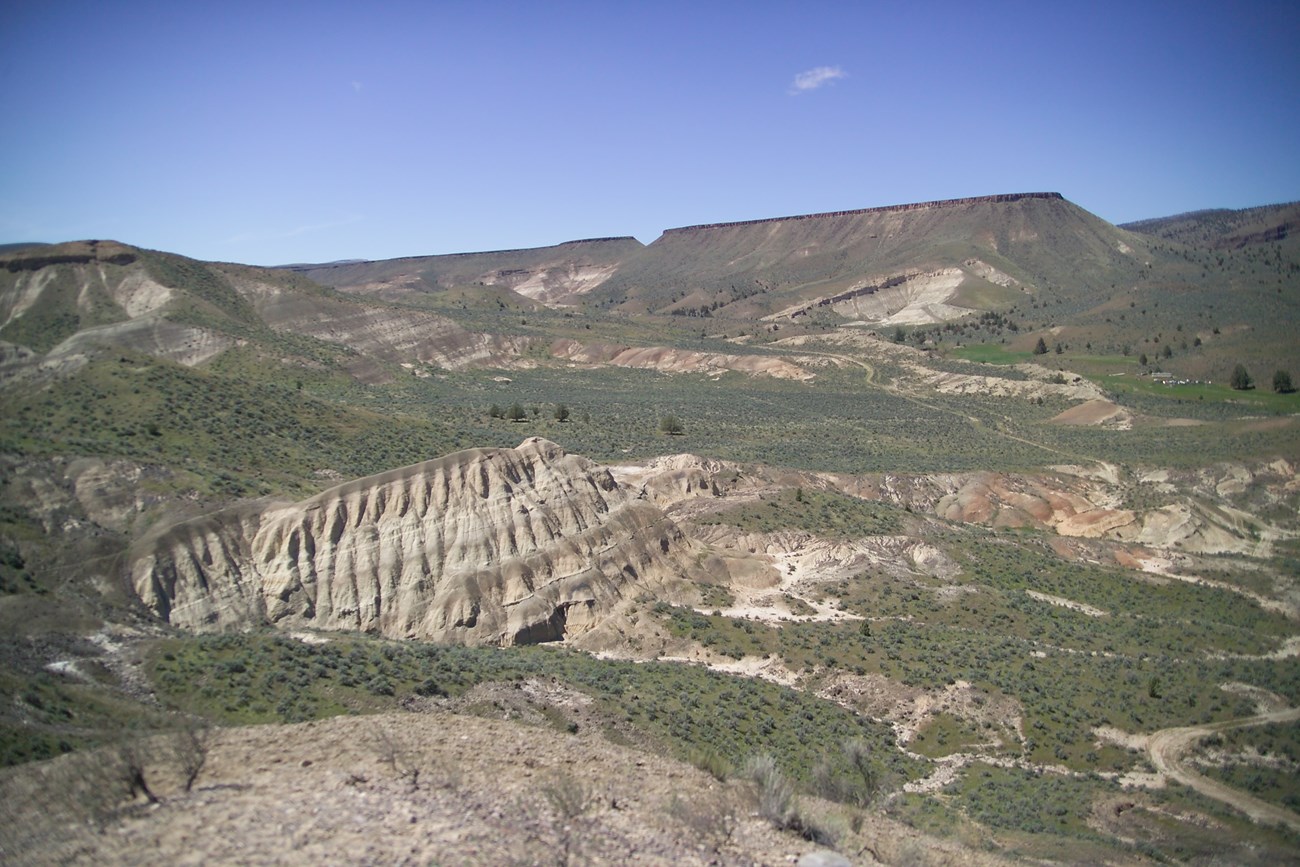
NPS Photo
Environmental Setting
John Day Fossil Beds National Monument protects one of the longest and most continuous records of evolutionary change and biotic relationships in North America. Here, scientists have unearthed fossils of land plants and animals dating back from 4.4 to 5 million years, as well as evidence of dramatic climatic changes. The Thomas Condon Paleontology Center supports ongoing research on these extensive fossil resources, and presents the results in impressive interpretive exhibits.
The monument includes over 14,000 acres found in three widely separated units: the Sheep Rock Unit, Painted Hills Unit, and Clarno Unit. All three units are in the John Day River Basin. The John Day River is the longest undammed tributary into the Columbia River.
Deep ravines that erode fossil-bearing formations bisect the steep mountainous terrain. Monument elevations range from 2,000 to 4,500 feet, and it lies within the Blue Mountain physiographic province in northeast Oregon. With average rainfall ranging from 9–16 inches, it is categorized as a semi-arid climate. Much of the precipitation for the area falls in the winter.
The river and streams are vital to the survival of many of the wildlife species inhabiting the monument. Over 50 species of birds, 40 species of mammals, 14 species of reptiles, six species of amphibians, and 10 species of fish inhabit the monument. Over 240 plants and flowers have adapted to the growing conditions found here.
Two research natural areas are located in the Sheep Rock Unit and protect nearly pristine vegetative communities. Seventy-five acres of agricultural land is irrigated and maintained to preserve the cultural landscape of the Cant Ranch National Historic District.
Key Resources and Issues
John Day Fossil Beds National Monument preserves and interprets world-class fossil resources illuminating millions of years of evolution in plants, animals, and ecosystems. In addition to the unique, colorful rock formations, the monument preserves extensive grassland steppe habitat, plus evergreen shrublands of juniper and mountain mahogany, and some sagebrush shrublands. Some of the higher and wetter areas of the monument sustain very healthy examples of bunchgrass steppe. The monument contains a segment of the John Day River as well as smaller stream segments, which support riparian vegetation.
The primary natural resource issues are wildfire, invasive species, water quality, and land-use practices. Historically, fire has had a major influence in the dry bunchgrass and sagebrush ecosystem of the monument. Suppression of fire allows juniper trees to encroach into the bunchgrass and sagebrush, but the use of prescribed fire can also result in substantial post-fire spread of invasive species such as cheatgrass and medusahead. For water resources, diverting river and stream water for agricultural use affects water temperature and dissolved oxygen, which has impacts on native fish populations. Riparian vegetation has been restricted by channelizing river and stream courses for agricultural land use and road right-of-ways.
Publications and Other Information
Inventory Reports
Source: NPS DataStore Collection 4404 (results presented are a subset). To search for additional information, visit the NPS DataStore.
Monitoring Reports
Source: NPS DataStore Saved Search 711 (results presented are a subset). To search for additional information, visit the NPS DataStore.
Source: NPS DataStore Saved Search 714 (results presented are a subset). To search for additional information, visit the NPS DataStore.
Source: NPS DataStore Saved Search 721 (results presented are a subset). To search for additional information, visit the NPS DataStore.
Source: NPS DataStore Saved Search 720 (results presented are a subset). To search for additional information, visit the NPS DataStore.
Quick Reads
Source: NPS DataStore Collection 4405 (results presented are a subset). To search for additional information, visit the NPS DataStore.
Last updated: August 27, 2018
